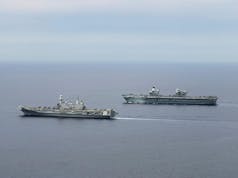Lockheed Martin recently signed a contract with Navantia to equip five new F-110 multimission frigates and their land-based test site (Centro de Integración de Sistemas en Tierra or CIST) – with Lockheed Martin’s first naval installation of its solid state S-band radar.
The new F-110 frigates will be built by Spain’s national shipbuilder, Navantia.
Recently designated by the U.S. Government as AN/SPY-7(V)1, this technology is derived from current radar programmes and significant Lockheed Martin investment. Variants of the SPY-7 radar will also be utilized on programs with Japan’s Aegis Ashore, the Royal Canadian Navy for the Canadian Surface Combatant Type 26 variant and the U.S. Government.
The F-110 will host the first-ever naval solid state S-band radar for the Spanish Navy. To foster the growth of Spain’s defense and technology industries, Lockheed Martin and Spanish company, Indra, will jointly provide the radar.
It will go to sea as part of the Aegis Weapon System, which will be integrated with the ship’s combat management system SCOMBA, when the first frigate deploys in 2026.
Lockheed say that the Aegis Weapon System is the most deployed combat system in the world, and its flexible system enables it to fulfil a variety of missions.
“Due in part to its unique open architecture design, the Aegis family continues to grow internationally as more nations around the world partner with Lockheed Martin.”













Lot of talk about the future going on. Even the hidebound naval and defense establishments have now realized that there has be a paradigm shift. They’ve been caught with their knickers down (as usual) and are flailing in an attempt to catch up. Regardless, IMO the fleets ( and militaries) of our countries in 30 years will look MUCH different than they do today…
https://news.usni.org/2019/12/05/navy-industry-still-talking-over-what-ship-designs-could-best-support-distributed-maritime-ops
Cheers
(been) sorry, sticky keys…
https://www.marinecorpstimes.com/news/your-marine-corps/2019/12/05/new-fleet-needed-marines-could-go-to-war-on-small-carriers-commercial-vessels/
Yes, an awful lot of discussion about this. You might find this report interesting, particularly as you’re (I think?) American, specifically page 8. Talks about what would really be a huge change in the USN’s force structure.
https://fas.org/sgp/crs/weapons/RL32109.pdf
Interesting article. Thank you Joe. IMO the next large surface combatant will be somewhere between the AB’s and the Zumwalts in terms of size, structure, and systems. The DDG 1000 hull form will probably also be modified. The AB’s hull has been maxed out in terms of development and from what I understand, the USN has been underwhelmed by the performance of the Z’s tumblehome form.
Also, it’s my belief that the USN will purchase no more than 6 GRFs total to replace the oldest Nimitz’s and will do a major life extension rehab on the rest to keep them in service for another 20 years or so. The carriers are becoming too vulnerable to attack now to maintain them in the traditional role they’ve filled since WWII. Large volume SSGNs will take on much of the carrier’s strike role.
Cheers
Cheers!
Hi Helions,
My experience of defence acquisitions is that flexibility usually means delays, cost over runs and generally huge waste. What worried me most the Newport News CEO saying he was not worried about rapid change because his experience team was retiring and many of his engineers had no more that 3 years experience! Sounds like the ingredient list for serious issues for the USN and USMC equipment programme.
I hope I’m wrong, but just look at the UK Astute SSN programme when you lose your experienced staff and the design changes – HMS Audacious is in effect a Batch 2 Astute with internal design changes (apparently) and is 17 month late and over budget even with US help…
All the comments from the main players seem to suggest a worryingly optimistic outlook. We used to call it the ,’conspiracy of optimism’, and it is the root cause of equipment programme failures in IMO.
I hope I am just being too pessimistic…
I think both the UK and U.S. military establishments could use one of these right now…
https://www.defensenews.com/global/europe/2019/12/06/britains-top-military-officer-wants-unvarnished-look-at-the-state-of-uk-forces/
A serious, unblinking non-partisan review. Could save us a lot of lives, treasure, and national humiliation down the line.
Cheers
Hi Helions,
Yes, I couldn’t agree more. The problem is, and always will be, the political aspect of defence. Any defence review needs political input to set the strategic aims and objectives. Since the end of the Cold War (and in fact earlier if we are being honest with ourselves) the strategic aims and objectives have been fudged or worse the assessment of our ability to deliver against them as been fudged with arguments of efficiency improvements – a very dishonest behaviour from politicians from across the party political spectrum.
So whilst I agree with your point I fear that the politicians will not allow a truly honest and independent assessment of where we are and just what risks we have imposed on our service personel and what threats we face as a nation and as partners in the wide context. They will have to set the boundaries to limit the political fall out that would inevitably follow a truly honest assessment.
Having said that I think there are signs that some politicians at least are becoming aware that all is not well within our defence capabilities and that something needs to change. This is best illustrated by the Parliamentary Defence Select Committee’s call for an increase in defence spending from 2% to 3% of GDP. Such a change will at best be years in the coming, but at least some politicians have now come out and said it is needed.
So I think we could see a drip, drip, drip of studies that justify a predetermined increase in spending. We could be greatly helped by another act of Putin bullying but given Salisbury I fear that the opportunity for something really awful is just too great – so such an act isn’t on my wish list.
So lets hope that those drips are big and come thick and fast. We can hope…
Good points all Chariot.
Cheers
USA really needs a frigate. If a type 31 costs 250 mill couldn’t you spend another 500mill and buy all the best of gear for it? Saving 250 million compared to a type 26… that’s an extra ship after every three built.
Too late, the US FFG(X) program is down to the last four designs, the future US Frigate will be based upon either:
a) Austal USA with a Frigate variant of the Independence Class
b) Fincantieri Marine Group & Marinette Marine with a variant of FREMM
c) General Dynamics & Bath Iron Works with a variant of the F100 Navantia Álvaro de Bazán-class F100 frigate/destroyer
d) Huntington Ingalls Industries& Ingalls Shipbuilding with a Patrol Frigate based on the US Coast Guard National Security Cutter
Lockheed Martin pulled their concept based upon Freedom class out of the competition which makes this announcement interesting. Integrating SPY/7 onto the F100 class leads to a design that is very close to what the USN wants. It should be noted that Bath Iron Works helped update the Navantia yard in Spain to allow construction of the Perry Class. Having been on an F100 class Frigate in Spain it is surprisingly similar to the Perry Class in form and fit showing the clear US influence at Navantia. The F110 class is now very closely aligned to what it required for FFG(X).
The only way for a T26 or T31 is if the USN and DOD find the current four proposals unsatisfactory and reopen the process to new designs, I am sceptical that will happen as this is a program that must succeed for the USN.
Huntington Ingalls is keeping its design for the new USN frigate secret. No one, outside of HI or presumably the US Navy, knows what it is. A modified US Coast Guard Security Cutter is one design speculated but only speculated. There are other possibilities. But it works to HI’s benefit to keep its proposal from public (and Competitor ) scrutiny.
That’s some impressive capability for the Spanish navy- particularly from the point of view of NATO interoperability! The big issue I can imagine them having is integrating AEGIS with their CMS; that could go really right or really wrong, and add a lot of cost and delay…